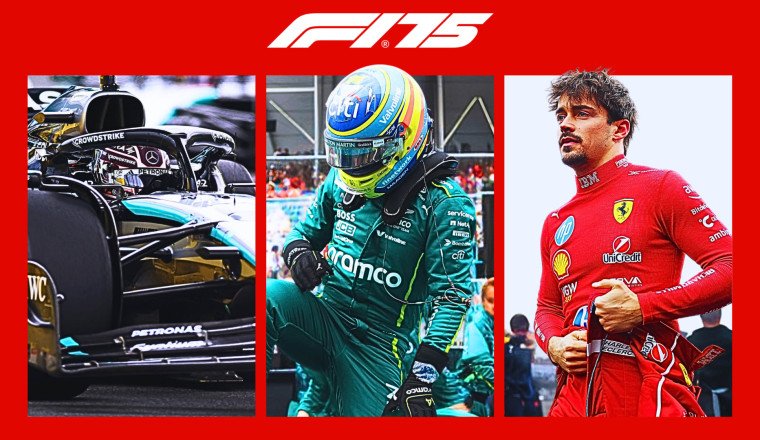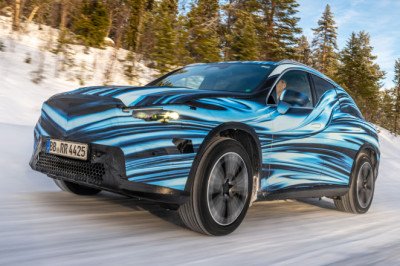
F1 can keep you on the edge of your seat. It can be exhilarating, glamourous, can make you hold your breath almost as though you were in the car yourself.
However, throughout history F1 has always had elements of danger. It’s easy to forget now, when safety technology and procedures are so intricate, but the sport has come a long way from the days of hay bale barriers. Here are five of the most impactful safety developments throughout F1's 75 years…
The ‘gentlemen racers’ of the post-war era tended to prioritise comfort and style over protection when it came to their race suits, with iconic drivers like Juan Manuel Fangio rocking polo shirts and slacks in the 1950s. He soared to unprecedented heights with his five World Championships, but the lack of adequate safety attire meant racers were not properly protected.
To tackle the terrible rates of drivers receiving burns in incidents during the early 1960s, the FIA introduced its first rules around wearing fireproof suits in 1963. F1 has the space experts at NASA to thank for this development – the Nomex ‘firesuit’ became popular across motorsport when astronaut Pete Conrad showed the material to NASCAR’s Bill Simpson.
Lauda heroically returned to the paddock soon after he left hospital following his crash in 1976
Unfortunately, as was shown by Niki Lauda’s fiery crash in 1976 at the Nürburgring – an incident the Austrian F1 legend survived but where he was left badly scarred – the cotton-based suits were still not protective enough.
A major swing in the other direction saw drivers, including Lauda himself, opting for heavy five-layer suits that were incredibly uncomfortable but offered added protection. By the time Ayrton Senna was racing for Lotus in 1987, the shoulder epaulettes alone were strong enough for a marshal to pull the driver out of a car.
With this enhanced focus on both fireproofing and making the attire comfortable and flexible, especially as the calendar expanded to include much warmer climates, race suits continued to evolve to suit individual drivers’ needs.
READ MORE: The 75 best drivers, cars, innovations, teams and key figures in F1 history
While many are close fitting, Jacques Villeneuve preferred his to be tailored in a more baggy style, for instance. Now, lightweight layers of Nomex fabric are used to make the suit breathable, and they are exposed to temperatures of up to 800°C in the creation process.
The mandatory fireproof underwear is similarly made of Nomex and must be able to withstand the same level of heat, ensuring that any (now much rarer) fires cannot affect the drivers as easily as they used to.
But even after so many years, progress is still being made. After Romain Grosjean’s crash at the 2020 Bahrain Grand Prix, new gloves were developed to improve protection from hand burns such as the ones the Frenchman endured.
F1 drivers must wear fireproofs under their race suits
Also referred to as the survival cell, the carbon fibre monocoque has been a critical component of F1 cars since McLaren unlocked the material’s potential back in 1981 for their MP4/1, piloted by John Watson and Andrea de Cesaris. Before its creation, cars were built around a rudimentary metal cage that provided minimal protection to the driver.
The driver sits in the monocoque and key features like the engine and suspension are attached to it, making it an integral part of the chassis that must be simultaneously durable and lightweight.
To achieve this, it’s made out of 6mm of carbon fibre layered with Kevlar, a heat-resistant synthetic fibre that is known for its use in bulletproof vests due to its remarkable strength and low weight. The combination of the two materials aims to prevent anything from penetrating the monocoque and contributes to absorbing energy during a crash.
The MP4/1 was the first F1 car with a carbon fibre monocoque
While it was originally created for aerodynamic reasons, as it made the car narrower, it has been continuously developed over the years to improve safety – now, it’s even fitted with a system the driver can activate that sprays fire retardant foam around the monocoque and engine.
It’s not just a static shell either – it also houses a complex network of wires and sensors that come together to form the car’s electrical system, controlling features such as the telemetry system that sends real-time data back to the team from the track.
And in addition to the extensive testing the monocoque undergoes ahead of each season, it’s also heavily scrutinised after every race to ensure that its structural integrity has not been compromised by any incidents. The smallest crack or sign of wear and tear will be amended by replacing the layers of carbon fibre, maintaining its high standard of protection.
The remnants of the chassis from Grosjean's fiery crash in 2020
Perhaps the most prominent safety advocate in F1 is Sir Jackie Stewart who, after witnessing dozens of accidents and experiencing his own horrific crash at Spa, campaigned heavily for greater safety procedures. His 1966 incident saw him hit a telegraph pole in heavy rain before slowing to a stop at a farm – the only people around to rescue him were fellow drivers Graham Hill and Bob Bondurant, both of whom had also crashed.
With no compulsory run-off areas and no medical or track crews, the Flying Scot pushed for a range of changes, from full-face helmets and mandatory seat belts to improved medical facilities and barriers.
READ MORE: The 10 greatest innovations F1 has given the world
Instead of hay bales and concrete, Armco barriers were introduced from the late 1960s onwards. Made primarily of steel, they are specially designed to disperse the energy that comes from a high-speed crash so that injury to the driver is significantly minimised.
Watch any crash from a recent race and you can see how the barrier tends to flex and change shape – this happens as the metal, which is molded in a ‘W’ shape, flattens out and absorbs the impact.
Barriers were non-existent at some early F1 races, such as the 1960 Grand Prix of the United States (pictured)
Software adopted by the FIA works to adapt these barriers to each individual circuit, perfectly calculating where and how they should be placed to prevent harm to both drivers and spectators.
And in a sport where every millisecond matters, every competitor tries to get as close as possible to the barriers to cut their time down, occasionally grazing them as they push to the limit. Another quirk of the design is that if a car does connect with the barrier, it will be directed along its line rather than turning off the track.
Armco’s prowess in F1 has been so successful that similar technology was introduced on UK motorways to lower the impact of any high-speed accidents.
READ MORE: Fearless racers and engineering masterminds – Influential women from every decade of F1
The HANS (head and neck support) device came about when brothers-in-law Dr Robert Hubbard, a biomechanical engineer, and Jim Downing, five-time IMSA champion, concluded that basilar skull fractures caused a significant number of fatalities among racers and little was being done to prevent them.
Barriers minimise the severe consequences of crashing
Their lengthy research process kicked off in 1981, and it took 14 years for the concept to reach F1. Following the deaths of Ayrton Senna and Roland Ratzenberger in 1994, the FIA enlisted the help of Mercedes-Benz to improve driver safety – they started by trying to adapt airbags to F1 cars.
Quickly, they found that the HANS device outperformed airbags, but it wasn’t until 1999 that a design suitable for the series was developed. After proven success in other championships – IndyCar’s Richie Hearn walked away from a 139G crash in Kentucky with just a broken foot – the FIA made HANS compulsory in 2003.
This came two years after the device was implemented in NASCAR following the death of American driver Dale Earnhardt, who got caught up in a three-car collision at the Daytona 500. While he had originally opposed HANS, labelling it restrictive, the devastating accident was further proof of its necessity.
Made from carbon fibre, it acts as a collar that is made to fit perfectly around the back of the driver’s neck, with two arms extending down onto the chest. It’s secured by safety belts and tethered to their helmet so that in a crash, their head doesn’t whip forward and neck injuries are subsequently reduced.
The HANS device significantly reduces head and neck injuries in crashes
Widely considered to be one of the greatest F1 safety developments of the last 75 years, the halo has prevented severe injuries in countless incidents, from Lewis Hamilton’s collision with Max Verstappen at the 2021 Italian Grand Prix to Zhou Guanyu’s heavy crash that saw him flipped upside down at Silverstone back in 2022.
When it was first introduced in 2018, the halo faced some criticism as it changed the historic aesthetic of fully open cockpits in single-seater series, but that has largely dissipated as the majority of the current grid have been kept safe thanks to the device.
Before this, all manner of debris could be flung into the cockpit in the aftermath of an incident, from shards of carbon fibre to whole tyres, leaving racers’ heads vulnerable with little but a helmet to shield them.

2022 British Grand Prix: Zhou Guanyu conscious but taken away in ambulance following huge crash at race start
It was Mercedes that originally came up with the concept 10 years ago, not long after Jules Bianchi’s fatal crash at Suzuka. Like everything in F1, it underwent rigorous testing before the FIA added it to the regulations – this included firing a rogue tyre straight at the cockpit to ensure the halo provided suitable protection.
The governing body actually researched three options of frontal protection devices – in another world, F1 cars might have a reinforced plastic windscreen, or a combination of this and a halo. But ultimately, Mercedes’ creation was deemed to be the most effective.
The final design became a three-pronged structure made from aerospace-grade titanium which can withstand a load equivalent to 116kN vertically downward or, as Mercedes’ James Allison put it, strong enough to hold a London double decker bus.
Don't miss your chance to experience the picturesque Imola circuit...
10 fascinating facts about the very first F1 race – held at Silverstone on this day 75 years ago
PALMER: Why isn't it clicking yet for Lewis Hamilton and Ferrari this year?
From brilliance in Baku to struggles in Sao Paulo – Colapinto’s 9 Grand Prix weekends so far ranked















Facebook Conversations